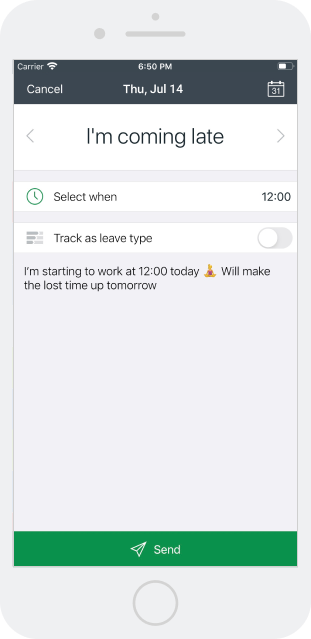Remote teams are growing more widespread, and the mandatory work-from-home period is not the only reason for that. Telework offers plenty of perks for employees and business owners. But it also brings many challenges.
To make sure that your business remains at the peak of productivity and attains all the desired performance goals, you need to implement the right strategies to reduce remote employees’ unplanned absences and help them stay committed and engaged in teamwork.
Below, we described the six best absence management practices for achieving just that. But first, let’s take a look at the most recent remote work trends, as well as the benefits of telecommuting.

Remote Work Trends
These days, it’s hard to surprise anyone by saying that you work remotely.
According to Zapier’s report, 31% of Millennial and 27% of Gen X knowledge workers telecommuted full-time in 2019. Meanwhile, over 70% of survey respondents who attended regular professional environments expressed their willingness to switch to remote work jobs.
Since employees perceive telecommuting as a major perk, the remote work trend is bound to accelerate further in the future. Besides, the global health crisis of 2020 has already tested many businesses’ abilities to perform remotely, and no adverse effects on employee efficiency were revealed. 76% of the founders of companies surveyed in a recent study by the Kung Group said that productivity either maintained or increased during the quarantine and the work-from-home period. Hence, as much as 70% of them are thinking of letting their employees continue telecommuting once the lockdown is over.
Main Benefits of Having a Remote Team
Higher productivity is not the only good reason to shift towards the remote work model. The benefits of telework are many for both employees and employers:
- Savings can increase thanks to zero communing costs and a lower need to run a physical workspace.
- Improved work-life balance and less stress for employees can result in a more satisfied and happier workforce for business owners. As a consequence, the staff turnover rate is likely to decrease as well.
- Higher workplace flexibility lets companies better attract talents from all around the world, diversify their teams and, thus, increase the business’s competitive advantage.
However, to gain these benefits of remote work, companies should be able to manage their telecommuting teams well and ensure that every employee is available when needed. Therefore, it’s pivotal to take into account remote team characteristics and implement the methods and practices that align with them perfectly.
Let’s explore the best options:
Best Absence Management Solutions for Remote Teams
1. Adopt a smart absence management system early
Remote teams are characterized by a considerable degree of flexibility. The very notion of telework implies that employers trust their employees enough to perform assigned duties in their own way. This means that remote team members can usually choose not only where to work from and but also when.
However, without any control at all, a remote team’s work process can easily go awry. In the context of flexitime, a manager needs to ensure that employees work the right amount of hours every day and that their schedules are aligned in a way that promotes effective communication and prevents the occurrence of performance bottlenecks.
To tackle the former, you may implement a time tracking solution to see how much each employee works a day and stay in the know of the ongoing task progress. But for the latter, it is pivotal to adopt a high-quality system for team scheduling and absence management since such a system offers the easiest way to plan staff members’ timetables and overview current resource availability.
Assume actiPLANS as an example. This scheduling tool has plenty of useful features for streamlined employee leave management. It allows for both the short-term and long-term time off planning. Besides, it enables users to review the schedule of colleagues, providing them with a clear picture of who’s on and off duty at the moment.

2. Communicate expectations from the very beginning
Just like absence management systems, organizational rules serve to give structure and prevent chaos. Thus, managers need to clearly communicate which remote work norms and standards their team members are expected to follow.
The best way to do that is by designing a telework policy. This document must cover such issues as conditions of employment, cybersecurity, occupational safety, communication, etc. For better absence management outcomes, it is appropriate to describe the company’s leave requesting and scheduling procedures and other pertinent matters in the policy as well:
- Should employees be working at a certain time of the workday?
- How many hours are they required to perform a day or a week?
- How quickly can their leave requests be approved?
- Which tools must they use to notify managers about changes in their personal schedules?
Think about other expectations you have in terms of leave and schedule management in your company and communicate them to your remote team members though the telework policy, as well as personal and group discussions.
3. Encourage planned vacations
According to SHRM, unplanned absenteeism results in significant productivity and financial loss for businesses. In contrast, planned vacations can promote more efficient behaviors in employees, allowing them to get their minds off work and recharge. Therefore, it’s advisable for managers to encourage remote workers to plan time off in advance and take longer breaks.
It’s helpful to utilize a scheduling and absence management tool for this purpose as well. For instance, actiPLANS has an automatic PTO accrual feature that displays employees’ time off balances and statistics in visual charts. It lets them see how much PTO they have at their disposal for any period of time (both in the present and in the future), which allows for effortless and error-free planning of personal leave time.

Of course, unplanned absences are very difficult to avoid entirely – people fall sick once in a while, whereas personal problems and needs sometimes require our utmost attention. Hence, staying flexible in terms of scheduling is crucial for employers even when they promote planned absences among their remote employees.
actiPLANS mobile app will help you track your colleagues’ unplanned absences easily. It allows users to notify others about any changes in their personal schedules promptly, which makes team communication more efficient and saves much time for everybody.

4. Arrange video calls and meetings regularly
Remote team members are usually located very far from each other in the physical space. They may live in different cities or even be from different countries and continents. Therefore, remote workers’ sense of connection to each other may suffer. They may feel lonely and isolated from colleagues and, as a consequence, may turn less engaged in teamwork and not so committed to the company as a whole. Such a situation can compel remote employees to take much more unplanned days off or even quit their jobs. Due to this, effective long-distance communication is a must for successful absence management in remote teams.
Use web-based conferencing tools to meet your remote colleagues face-to-face regularly. Arrange short daily video calls to talk about their current performance progress and discuss the problems your team members encounter when working. In addition, utilize video calls as a means to promote employee morale and increase team cohesion. Gather your employees in a chat room to share some fun and friendly conversations at least once a month. In this way, you will help everyone feel a part of the team and establish meaningful human connections.
5. Be always available
Continuous leader availability is important in remote teams for several reasons:
- When employees know that a manager is present at work and pays a great deal of attention to his or her managerial duties, they become more motivated to show up and produce good performance results too.
- Conversely, when remote workers experience troubles and have no one to help them out immediately, they are likely to become discouraged. As a result, they may start to invest less effort in work when feeling that nobody supports them or cares about their outputs.
- Without constant employee-manager communication, it’s also hard to see workers’ actual contributions. Only by staying in touch with their team can a manager provide constructive feedback and recognize achievements, which is highly rewarding for employees in any workplace setting.
Therefore, as a manager and a leader, you need to be always available to your remote team members and be ready to assist them quickly. Tell your employees how they can reach you throughout the day and offer more than one contact option: email, phone number, social media accounts, etc. Such a simple measure will enable you to make sure that everyone feels supported and heard.

6. Collect and analyze employee absence data
Data on different aspects of team performance are very informative for businesses. When analyzed against the progress and output trends, employee absence statistics can show you how adequate your management approach is and identify any problems in the team’s way of conduct. This knowledge may help you enhance your team management strategies and foster many improvements more efficiently.
With actiPLANS, the employee leave time data will always be readily available to you when needed. The tool allows users to categorize time off types in any convenient way and provides a detailed overview of the team’s history of absences in reports. As a result, you get greater transparency in terms of absence management in your remote team and more in-depth insight into your employees’ leave trends.
Ready to give a smart absence management system a try? Sign up for a free actiPLANS trial today!



